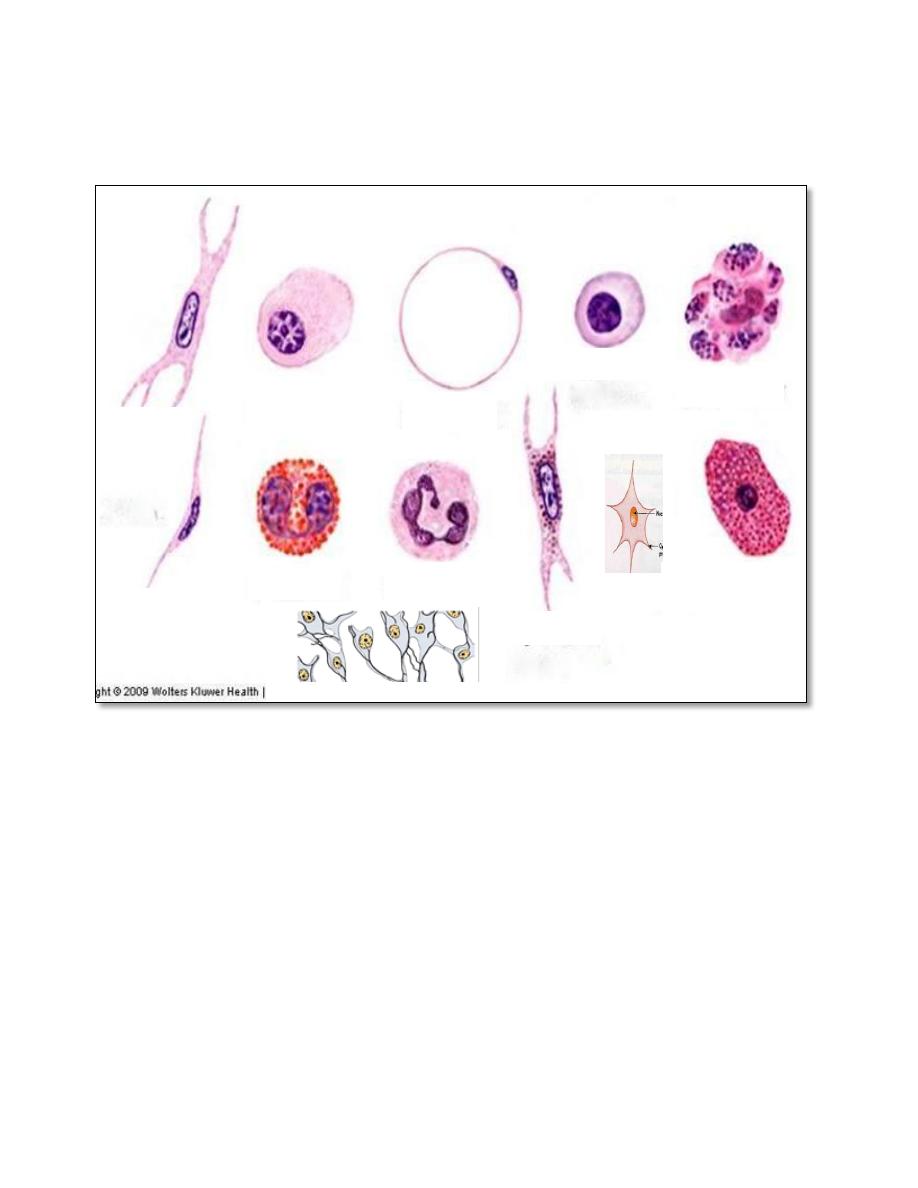
1
Lec.4
Biology
Histology
Connective tissue cells:
There are specialized cells in connective tissue which form and maintain
extracellular matrix. They may be immature cells with name ending in -
blast. These cells can reproduce and form the matrix. May be mature cells
names end in - cyte. These cells have a reduced ability to divide and
maintain matrix. May be for remodeling of matrix , names end in clasts.
The cells of connective tissue can be grouped into: Fixed cells - appear in
tissues in stable numbers . Wandering cells - found in tissues only in
response to infection or injury .There are many types of cells found in
connective tissue:
1. Fibroblast: It is the most common cell found in the connective
tissue, the young fibroblast is star in shape with many processes, the
nucleus is large oval & pale in color while the mature cell is called
"fibrocyte", which is smaller than fibroblast, it is spindle in shape
have few processes, the nucleus is smaller, darker & elongated. The
function of fibroblast is the formation of fiber & matrix.
2. Undifferentiated mesenchymal cells: these cells have ability to give
rise any kind of cells, they are smaller than fibroblast and Stellate in
shape.
3. Macrophages: they are either fixed or wandering, the fixed
macrophage known as histiocytes, while the wandering macrophage
is called amoeboid. The fixed macrophages are spindle or star in
shape have an ovoid nucleus while the wandering is irregular in
shape and the nucleus is round. The functions of macrophage is
engulf of the foreign bodies and accumulate it in their cytoplasm in
the form of granules by their thick pseudopodia .

2
4. Pigment cell: they are elongated cells with short irregular outgrowth,
the cytoplasm contains small granules of melanin (brown or black
pigment granules).I t is seen in the skin and eyes.
5. Reticular cells: they are star in shape with processes extending in
several directions and often in contact with the processes of
neighboring cells, they lie between the reticular fibers, they engulf
the foreign bodies. They are found in lymphatic nodes, spleen and
liver.
6. Plasma cell: it is ovoid in shape with eccentric nucleus , the
chromatin granules in the nucleus are coarse and deeply stained, they
arranged at the periphery of the nucleus forming a cart- wheel or
clock face appearance . The function of plasma cell is the formation
of antibodies against antigen which enter the body.
7. Mast cells: they are large ovoid in shape with small ovoid nuclei and
coarse cytoplasmic granules .The function of mast cell is the
production of heparin (anticoagulation) and also produce histamine
(vasodilator) which cause dilation of capillaries.
8. Fat cells: these cells found singly or in groups contain fat globules,
are derived from undifferentiated mesenchymal cells. The function is
the synthesis and storage of triglycerides.
There are two types of fat cells:
(1) Unilocular fat cells: cells with a single, large lipid droplet form
white adispose tissue.
(2) Multilocular fat cells: cells with multiple, small lipid droplets,
form brown adipose tissue.
9. Some blood cells: some types of blood cells might be seen in the
connective tissue, in special conditions such as neutrophils in the site
of infection, eosinophil in the site of sensitivity and lymphocytes in
the chronic infection.

3
(
Connective tissue cells)
Mast cells
Macrophage
lymphocyt
e
Fat cell
Plasma cell
Fibroblas
t
Mast cell
Pigment cell
Neutrophil
Eosinophil
Fibrocyte
mesenchymal cell
reticuler cells
